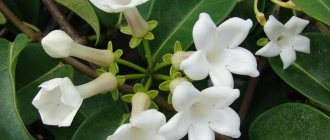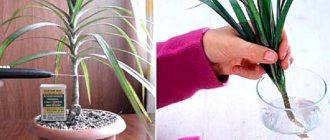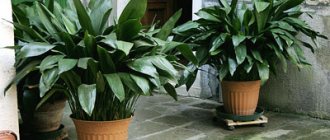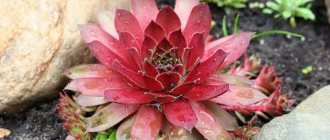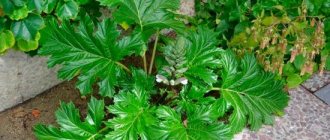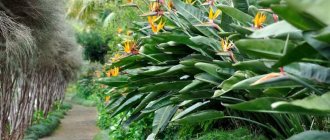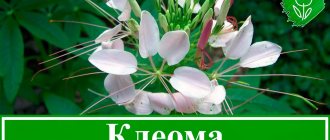What Trillium looks like, description
Trillium is a perennial plant that prefers broad-leaved, moist forests. Thanks to its extraordinary appearance, the culture is gradually settling in different parts of the world and is used as a spectacular element in landscape compositions. Of the 30 species that mainly grow in East Asia and North America, 3 species live in Russia, in the Far East. Trillium species can be distinguished by the arrangement of the flower. Some are characterized by the absence of peduncles, and the flowers seem to be glued to the leaves; some species have a straight peduncle with a flower directed upward, while others have drooping peduncles and flowers directed towards the ground. Trilliums bloom in April-May, but not for long, from 5 to 15 days.
Variety of Trillium grandiflora with large and double flowers
Trillium grows and blooms well in conditions similar to natural ones. Therefore, trilliums are planted under the shade of trees . They create diffused light, creating optimal conditions for flowering . In areas where trilliums grow, increased requirements for soil fertility and moisture are expected.
What has America given us, or are our own people more reliable?
Trillium is an excellent plant for a shady garden. However, it must be borne in mind that they do not tolerate loneliness well; they are best planted in groups. And remember that the decorative peak of trillium planting is not achieved immediately, but over the years, as the rhizomes grow. But it doesn’t take many years to transplant.
The plants are decorative throughout the season, mainly due to their unusual leaves, decorated with dark spots in some species. But, of course, the peak of decorativeness occurs during the flowering period. In the Moscow region this is the second half of May - early June. In addition, many species are also decorative at the end of summer, in August, when dark red berries ripen.
Common types
Kamchatsky
The most famous, unpretentious and decorative species , 15-40 cm high, with a thick rhizome and ribbed stem. The flowers are white, directed upwards.
Trillium Kamchatka or Trillium rhombifolia is a herbaceous plant; species of the genus Trillium of the family Melanthiaceae
Large-flowered
A beautiful plant with large (up to 8 cm) flowers directed upwards, having white or white-pink shades. Stem height - up to 50 cm . The double shape of the flower looks extraordinary .
The most famous and beloved species is Trillium grandiflora, double variety
Erect
The plant is about 60 cm high . The flowers are dark red or greenish in color and look upward.
Trillium erecta with magical burgundy flowers
Description
Trillium is a shade-tolerant perennial plant. It will perfectly fill your shady corner, delighting you not only with flowering, but also with quite decorative leaves. In addition, at the end of summer, red fruits and berries are formed on the plant.
Each small stem bears a single white, red or yellow flower.
The color of the flower, of course, depends on the variety, as well as the height of the plants. The smallest can be only 15 cm, the tallest - 70 cm.
Some varieties bloom in late spring, and some in June, so by planting these plants in your garden, you will bring the arrival of spring to your garden!
How to propagate a forest flower
Most often, trillium reproduces by dividing the rhizome. In September, an adult bush is dug up and the rhizome is divided into several parts with buds. The sections should be dried and sprinkled with activated carbon. Each part of the root is planted separately.
At the same time, it is advisable to add dolomite flour and superphosphate (1 tablespoon) to the planting hole, mixing them with humus.
Despite its frost resistance, with the onset of cold weather it is recommended to insulate the plant with leaves, crushed bark or leaf compost. In one place without transplantation, trillium can grow for up to 25 years.
Trillium propagation by seeds is a more complex process. Trillium seeds are numerous and quite viable, but due to the species characteristics, at least two years pass before the seeds germinate naturally.
Trillium Seeds
To speed up the process, stratification is carried out. To do this, at the time of seed ripening (in August) you need:
- Place the seeds in a mixture of peat and moss, moisten;
- Place the container with the seeds in a plastic bag and put it in a cool place (in the refrigerator);
- After 3 months, remove the container from the refrigerator and, without removing the bag, place it in a dark place for 3 months;
- Refrigerate again for 2-3 months.
By May, the seeds should germinate; they are planted in containers and taken out into the open air. Shoots will appear in 2 weeks. After they get stronger, they are transplanted into open ground with an interval of 25 cm, deepening them by 8-10 mm.
Fertilizing with mineral fertilizers is mandatory in two cases: at the time of seedling growth and after flowering.
Planting and caring for Trillium grandiflora flower
The most favorable place for cultivating a trillium flower is a completely shaded area, without exposure to sunlight. In sunny meadows the plant fades and the flowers are completely absent. Semi-shaded areas are acceptable, but without the presence of berries and fruit crops in the neighborhood.
For planting, you should choose a place with loose soil of moderate acidity. The close location of groundwater can harm the root system; this nuance must also be taken into account before planting.
Planting pattern:
- when sowing seeds, a hole is made to a depth of 5-7 cm, when planting rhizomes - 15-20 cm, depending on the size of the planting material;
- the distance between the holes varies between 30-35 cm;
- for quick rooting, it is recommended to add 3-4 g of superphosphate to the hole;
- After the event, the holes must be watered and a thin layer of humus or peat placed on top.
During planting, it is necessary to familiarize yourself with the characteristics of the cultivated variety and carry out the event, taking into account all the nuances.
Further care involves fairly familiar activities, which include watering, loosening and fertilizing.
Water the plant moderately, as needed. It is important to remember that waterlogged soil will negatively affect the appearance of the ornamental plant.
It is recommended to loosen the soil at least once every 10 days. This procedure will help the root system become saturated with oxygen.
When loosening, you need to be extremely careful so as not to damage the roots located in the upper layers of the soil.
Fertilize the soil 2-3 times during the growing season. The first fertilizing is carried out in early spring and involves the application of fertilizers with a high nitrogen content, which will help increase green mass. For subsequent fertilizing, use any complex fertilizers that can be purchased in specialized stores.
Diseases and pests
For young plants, gray rot is most dangerous, mainly in rainy seasons. Excess moisture provokes fungal diseases.
Gray rot is a very common and quite dangerous fungal plant disease.
Young shoots are also susceptible to attack by snails and slugs. You can fight them by collecting them by hand or sprinkling metaldehyde around the plantings.
In addition to trillium, slugs are also pests of strawberries, pumpkins, carnations, phlox, cacti, cabbage, potatoes, rhododendrons, cucumbers, cannas and colchicum.
Trillium is indispensable when creating beautiful compositions in the design of a site. In order to emphasize the exotic beauty of trillium, it is necessary to wisely select its neighbors - plants that prefer shaded areas. But individual trilliums growing separately look no less impressive than in the vicinity of other plants. Unlike other primroses, trilliums do not lose their leaves until late summer.
Trillium in the garden
Conditions necessary for the plant
Since trillium is a shade-tolerant plant, it should be planted in partial shade. Therefore, this is an excellent option for decorating shady corners of the garden.
It is often placed under the canopy of trees, in a tree trunk circle.
The flower will look great planted in front of the bushes. In the spring, while there are few leaves on the trees, it will bloom.
But in the open sun, the leaves of the plant can burn.
It is advisable to plant trillium in fertile soil, which must be regularly moistened, avoiding stagnation of water. It is good if the soil contains plenty of humus from the leaves of oak, linden and other deciduous trees.
When choosing plants, it is important to consider how well they tolerate frost.
There are some species that winter poorly in the middle zone and need good shelter. But there are also those that do not need to be covered at all.
The fruits of many trillium species are edible and even beneficial for the human body!
Flower propagation
It is more convenient to propagate trillium by dividing the bush. Divide the bush at the end of summer or in September so that the resulting pieces of rhizome have apical buds.
Combination with other plants
This flower looks great in the company of plants such as mantle, corydalis, fern, lily of the valley, liverwort, anemone and many other early spring flowers and plants.
For professionals
A qualified development center is provided for knowledge exchange between experts from Grasse and Kannauj. There are workshops here to actually produce the scents on site. Thermal gain analysis was carried out to optimize the depth of the cantilever to ensure minimal thermal gain on the façade of the museum itself, resulting in reduced air conditioning costs. Plants planted along the paths are selected in such a way as to create maximum shading for visitors.
Found a violation? Report content
